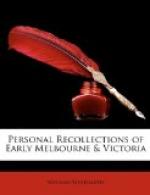Taking central Collins-street, which was then, and I suppose is still, the chief seat of business, and beginning with “The Shakespeare,” at the market corner, where originally Fawkner opened the first public-house, and proceeding eastwards to Swanston-street, there was a good sprinkling of brick-built offices, stores, and shops, including Kerr and Holmes, in stationery; Drummond’s grocery (wooden), Turnbull, Orr and Co., Forsyth’s druggery, the Imperial Inn, Pittman, Dinwoodie’s saddlery, Townend’s corner (wooden), George James’s wine office and house, and the ill-fortuned Port Phillip Bank. Returning by the other side were Hood, chemist; Cashmore, draper; Carson, shoemaker; J.M. Chisholm and the Benjamins, soft goods; the hardware shop of William Witton, a leading Wesleyan, his Wesleyan Church, and the Bank of Australasia, which towered up, prince of the small squad. To the far east, on the south side, was our worthy Dr. Howitt’s good house and garden. On the other side were some few small brick dwellings. One was occupied by Deputy-Assistant Commissary General Erskine. In another was Dr. Hobson, whose untimely death was an early grief to our small society, unable to spare such lives. He was the friend and correspondent of Professor Owen, and supplied the Prince of Science with curious data of the strange, and then but scantily known, Australian fauna, from the platypus, at the head of modern wonders, back to the earliest marsupialdom of the fossil world.
The Reverend Alexander Morison’s Independent Church and adjacent manse came next. The Scots Church, lower down, of which the Reverend James Forbes was minister, was then being built. Not till the next year was the creditably large Mechanics’ Institute begun. A good story is told of it, characteristic of the earlier flourish of the times. Mr. P.W. Welsh, then the leading merchant, had offered to subscribe so largely that the committee took offence at such vain presumption, and limited subscriptions to more modest sums.
Returning to the market place, and taking its eastern side, was a small nest of early merchants—E.M. Sayers, whose stores my firm bought eight years later; Watson and Wight; Were Brothers, whose senior, the well-known Mr. Jonathan Binns Were, was always, under all fortunes, a prominent and influential merchant and citizen; W. and H. Barnes and Co., and perhaps one or two more. But as the buildings are not given in Mossman’s sketch, they probably belong to the end of the year, or possibly tide over into 1841. Towards the foot of the market slope the first Custom House was being built, and of that dismal, dark-brown indurated sandstone, of which other places—St. James’s Church, the old gaol, etc.—were also built, because it was so near at hand.




